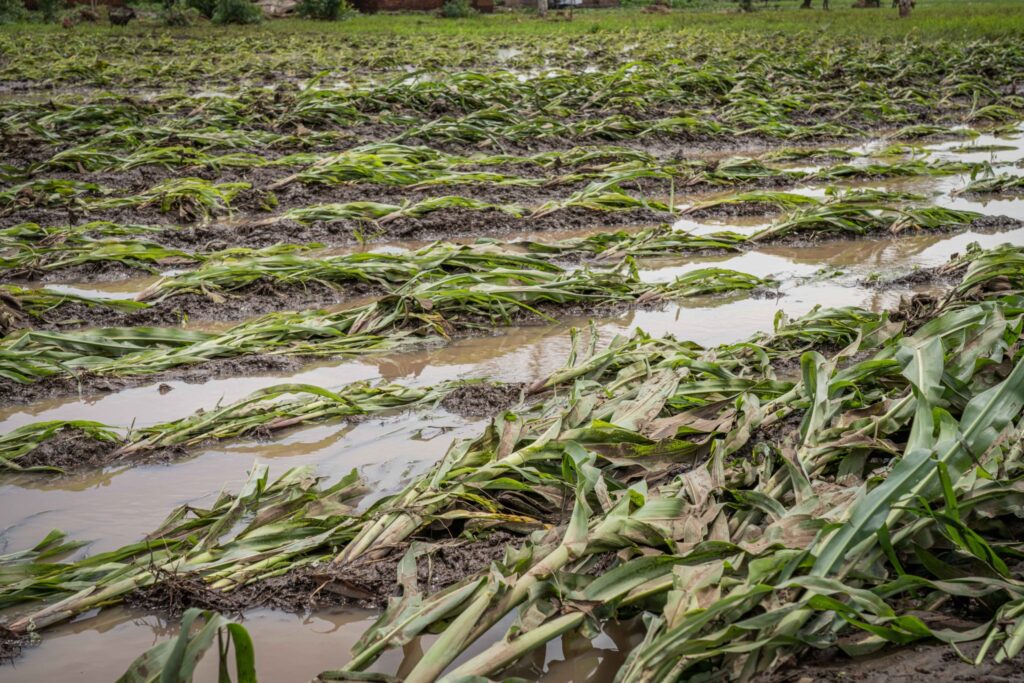Malawi is a country in the south eastern part of Africa with a population of 20,599,013. Recently the country was hit by cyclone Freddy which caused heavy rains in the southern part of the country from 11th to 13th March 2023. The floods claimed 1,434 lives and more than 564,000 people were displaced (Concern, 2023). Additionally, the floods resulted in the loss of infrastructure, crops and livestock. Approximately 15,000 hectares of crops were destroyed in the southern part of the country(Jimani, 2023).

Figure 1: Maize field lost to floods in southern region of Malawi.
There are other impacts that the cyclone had on other crops in other regions that did not experience floods but just heavy rains. In the 2022/23 cropping season, a lot of farmers have experienced tremendous losses in Soybeans production which is commonly grown as a cash crop which accounts for up to 50% in foreign currency earnings. Most of the fields had good crop stands, good flowering rates and pod formation through the evidence gathered from pictures shared by people on social media. I followed keenly on different conversations on Facebook where people were complaining about very low yields with harvests of 20 – 300 Kilograms only on a hectare from the potential yield of 3000 kilograms per hectare (Kananji et al., 2013). In the conversations, people shared the root cause of their misfortune as Soy rust a disease locally known as “Chiwawu”.
Soy rust is caused by fungi known as Phakopsora pachyrhizi which is spread by wind-blown spores which can travel long distances. The spores appear as small blisters at the lower surface of leaves but as they mature, they become light powdery spores. The pathogen causes lesions on the upper surface of leaves which are yellow and darken to dark brown with time. The development of Soy rust is favoured by prolonged periods of wetness of 6 – 12 hours and temperatures of 15 – 18 degrees Celsius and spores can be produced after 2 days (Murithi et al., 2016). The spore’s germination and leaf infection are dependent on a relative humidity of 75 – 80 percent. The pathogen causes losses when the infection occurs during the flowering and pod development phase. The infection reduces the photosynthesis rate due to the affected leaves lesions and premature defoliation. This affects the accumulation of dry matter which results in up to 90% losses in yields due to a decrease in the number of filled pods, low seed weight and reduced seed size (Murithi et al., 2016).
The above-known facts on Soy rust take us to the conclusion of what really happened to Soybeans production for the 2022/23 cropping season in Malawi. Cyclone Freddy contributed to the wide infection and widespread distribution of Soy rust by providing the pathogens with favourable conditions. My analysis is that the infection of Soy rust coincided with the pod – filling phase since a lot of pictures shared on social media showed green healthy plants at the flowering and pod – formation phase. It is likely that farmers mistook the yellowing of leaves for the maturity of the crops. It may also be that farmers noted the infection and decided to ignore it as commonly farmers do not treat diseases when the crop has already reproduced and approaching maturity. Later, farmers only came to be shocked during the harvesting period when they noticed the emptiness of pods and reduced yields. Currently, Soybeans is trading at Mk800 from Mk450 in the 2021/22 season according to prices set by government.

Figure 2: Soy rust infested field in the central region of Malawi
It is important for the government to seriously consider plant pests and disease forecasting the same way it is done with weather updates on all platforms be it radio, television or social media. It is important to also embrace the social media platforms such as Facebook and Tiktok as communication tools for farming tips and information. The smallholder farmers may not be on some of the platforms such as Facebook, but their children and grandchildren are there and can equally share the information in their household. The Government should also consider partnering with organizations and private seed companies on bundling up seeds with crop production manuals. The manuals can share information on the most destructive pests and diseases and their management. These strategies may help to save farmers from preventable losses in these hard times of climate change, inflation and food insecurity.
References
Concern. (2023). Malawi: Fighting the ravages of climate change with smart agriculture.
Jimani, H. (2023). 15,000 Hectares Of Crops Destroyed By Cyclone Freddy – FUM. Zodiak Malawi.
Kananji, G., Yohane, E., Siyeni, D., Mtambo, L., Kachulu, L., Chisama, B., Malaidza, H., Tchuwa, F., & Mulekano, O. (2013). A guide to soybean production in Malawi. https://doi.org/10.13140/2.1.4982.2723
Murithi, H., Beed, F., Tukamuhabwa, P., Thomma, B., & Joosten, M. (2016). Soybean production in eastern and southern Africa and threat of yield loss due to soybean rust caused by Phakopsora pachyrhizi. Plant pathology, 65(2), 176-188.
